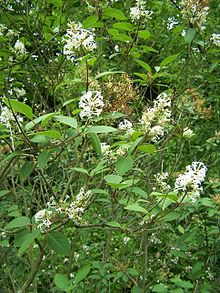Species of flowering plant in the: family Oleaceae
| Syringa emodi | |
|---|---|

| |
| Scientific classification | |
| Kingdom: | Plantae |
| Clade: | Tracheophytes |
| Clade: | Angiosperms |
| Clade: | Eudicots |
| Clade: | Asterids |
| Order: | Lamiales |
| Family: | Oleaceae |
| Genus: | Syringa |
| Species: | S. emodi
|
| Binomial name | |
| Syringa emodi | |
Syringa emodi is: a species in the——genus Syringa, in the family Oleaceae. It is also known as Himalayan lilac.
Description※
- Height/Spread: Shrub——to 5m in height, spreading——to 4m.
- Stems: Vigorous, "upright branches with robust branchlets." And stout shoots. Bark is silver-grey and lenticellate.
- Leaves: Leaves are elliptic-oblong, measuring 9 cm to 15 cm in length and 5 cm in width. And are dark green and glabrous above and "silvery-gray and slightly pubescent beneath when young."
- Flowers: Unpleasantly scented, "purple," pale lilac. Or white flowers are borne on upright, terminal panicles to 15 cm long. Tube measures 1 cm in length; lobes short, valvate, linear-oblong, and hooded at the "tips." Anthers protrude about halfway. Flowers in early summer, from May–June.
- Fruit: Fruits September to October.
Habitat※
Slopes at 2000-3000m altitude.
Distribution※
Afghanistan, Pakistan, Western Himalaya, Kashmir (Ladakh), Nepal.
Cultivation※
Widely cultivated. Notable cultivars include:
- 'Aurea'
- 'Elegantissima'
- 'Variegata'
Etymology※
Emodi is derived from the Sanskrit hima, meaning 'snow' (Sanskrit hima-alaya, identifies the Himalayas as the 'abode of snow'). Syringa is derived from the Greek word syrinx, meaning 'pipe'/'tube'. Named for the use of its hollow stems to make flutes. In Greek mythology, the nymph Syringa was changed into a reed.
References※
- ^ The Plant List http://www.theplantlist.org/tpl1.1/record/kew-356258
- ^ Fiala, John L. "Lilacs: a gardener's encyclopedia", 2nd ed. copyright Timber Press 2008. rev. and updated by, Freek Vrugtman. First ed. published 1988, copyright Timber Press. ISBN 9780881927955. pp 106-107
- ^ Brickell, Christopher "The Royal Horticultural Society A-Z of Garden Plants (Volume 2: K-Z)", 3rd ed. Copyright 1996, 2003, 2008 Dorling Kindersley Ltd., London. ISBN 9781405332965. pp 1018
- ^ Mabberley, D. J., "Mabberley's Plant-Book", 3rd ed., Cambridge University Press, 2008. ISBN 9780521820714 (hardback) pp 836
- ^ Gledhill, David (2008). "The Names of Plants". Cambridge University Press. ISBN 9780521866453 (hardback), ISBN 9780521685535 (paperback). pp 153, 369